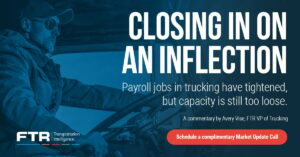Frustrations over the misclassification of employee truckers as personal services businesses — the so-called Driver Inc. model — are mounting as a tough freight market has heightened the impact the unfair competition has had on traditional fleets.
“Carriers are pissed,” said Mark Seymour, CEO of Kriska Transportation Group, speaking at the Truckload Carriers Association’s Bridging Border Barriers conference this week. “The government simply doesn’t want to do anything.”
Asked if his business has lost contracts to competitors using the Driver Inc. model, Seymour said “Yes. Constantly. Last year there was more work than anyone could do, we were in a price-setting environment and it wasn’t as troublesome for our business. But now it’s a big problem and yes, we’re losing a lot of business.”

Stephen Laskoswski, head of the Ontario Trucking Association (OTA) and Canadian Trucking Alliance (CTA), contends Driver Inc. fleets save as much as 30% on labor costs by circumventing certain payroll taxes by illegally classifying company drivers as independent contractors.
“Our message is simple to government and to industry,” he said. “This is clearly illegal, there is no grey area. It’s black-and-white but, unfortunately, we have a government that’s decided not to enforce the law.”

Repositioning empty trailers
Another frustration for Seymour, Laskowski, and Laskowski’s American peer Bob Costello, chief economist with the American Trucking Associations (ATA), is a lack of progress in having regulators allow the movement of empty trailers from point to point in the U.S. Repositioning empty trailers has clear environmental and productivity benefits, but lawmakers are stubbornly resisting regulatory changes that would allow this.
“If we have the option to drop a loaded trailer, grab an empty and go somewhere else, it makes more sense than a driver idling in their truck for five to eight hours while getting live unloaded,” Seymour said. “It makes no sense.”
And he said many carriers reposition empties in the U.S. every day without consequence, gaining an advantage over those who follow the rules by the book. The CTA, TCA and ATA are all in favor of modernizing regulations to allow for the repositioning of empty trailers across the border.
Costello vowed: “We are actively, I promise you, working this issue constantly because it just makes sense.”
But he said resistance comes from corners within government that feel if the rule is changed for trucking, it will also have to apply to other modes. And if it applies to Canada, it’ll have to be extended to Mexico as well.
“And when that happens, that’s when the labor unions start to get worked up,” he said. “I proposed, let’s do a pilot project just with Canada. Then they come up with another excuse.”
Too much capacity
Earlier in the day, Costello gave a grim economic outlook for carriers in the room, noting more capacity will have to leave the market before supply and demand come back into balance. While Kriska doesn’t have much exposure to the spot market – where the biggest freight volume and rate declines have been seen – Seymour said he doesn’t see a quick turnaround for the industry as a whole. But while the pace of bankruptcies in the U.S. has accelerated, Seymour isn’t seeing the same in Canada.
“I have to think it can’t be far away,” Seymour said of a thinning of capacity in Canada. “We are a resilient bunch by nature, but I don’t know how people can stand much more inflationary costs coupled with pressure on price.”
Laskowski said such pressures are exacerbated by government initiatives – such as carbon taxes – that further increase costs for truckers. “Our message from carriers to government is, you need to be aware of that and be cautious in what you’re doing and what kind of costs you’re putting on the carrier community,” he said.
Costello repeated his message that a freight recovery will not be demand-driven, but will instead require trucking supply to be further reduced. The most likely victims will be smaller fleets that heavily rely on the spot market, especially those who entered the industry in the recent boom times and overpaid for used equipment.
That used equipment, incidentally, is not fetching nearly what it was a couple years ago.
“It isn’t worth anything,” Seymour said. “You’ll move it, unless it’s a complete dog. But the fall from values last year that we got addicted to, it’s very different now. It’s just another headwind we are facing as we dispose of used equipment.”
Unrealistic emissions timelines
Panelists also expressed some frustration over government-driven mandates to decarbonize trucking, specifically the aggressive and unrealistic timelines imposed by organizations such as the California Air Resources Board.
“We, as an industry, are committed to reducing our carbon footprint,” Laskowski said. “The issue becomes fictional timelines. We can’t make those timelines, not because we don’t want to or don’t want to spend the money, but because the technology is not there yet, the infrastructure is not there yet, or the maintenance is not there yet. There’s a whole bunch of issues and challenges.”
The electrical grid is also not yet ready to support electric trucks, Laskowski said, relaying the story of one member in a small community that bought a single Class 8 BEV and caused brownouts in the community when charging it.
The frustration is shared south of the border. Costello said he’d prefer regulators to set the target, then let industry achieve that target as it best sees fit.
“Set the target and say ‘Hey industry, go figure it out.’ They’re telling us it has to be BEV. That’s a problem. If they care about getting carbon out of the air, we could achieve a 60% reduction in very short order,” Costello said, referring to readily available and practical technologies that exist today. “It’s not only unrealistic timelines, it’s also the flexibility to get there – as long as we hit those targets let us get there in the way that fits us best.”
Asked for a bold prediction for the year ahead, Seymour suggested carriers buckle in for a couple more quarters of challenging times.
“What is likely to change the situation is a contraction in supply,” he said. “Truckers are resilient, determined, and find ways to muck it out. I think it’ll be a slow burn on the way down for capacity contraction and if that’s what it’s going to take to make us all feel better, we should probably fasten our seatbelts for a couple tough quarters in 2024. The situation we feel right now is likely not going anywhere for a while.”










